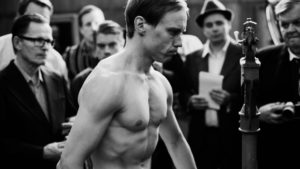The Happiest Day in the Life of Olli Maki
4/5
The Happiest Day in the Life of Olli Maki (2016) is the story of a man caught between opposing forces—on one hand, the opportunity for greatness and to do right by his nation, and on the other, love, inopportune and unavoidable.
It’s a film entrenched in the past—set in 1962 and shot gracefully in black and white, the story unfolds without getting tangled in plot lines, and has the same fluidity of late-1950s European cinema—but is also one that seems inextricably tied to the present day (politics aside). It presents a man beset on all sides by things that only half-interest him, and his resulting unhappiness might be likened to wasted days scrolling through internet content, things that attract without any real or lasting reward.

The film itself could not be any more different than that experience—The Happiest Day is electrifying to watch in every respect: the camera movements are smooth and clean (though not polished with expensive equipment), the editing is remarkably entertaining, giving a film about indecision an electrifying pulse, and although the acting is superb throughout the cast, Kuosmanen’s camera seems particularly drawn to Oona Airola, who illuminates every frame she’s in.
At times I think the film might hold its cards too close to its chest—Olli Maki remains a bit of an enigma throughout—but nothing detracts from the whole, or from the impact of its gradual conclusion. It’s a beautiful film visually and thematically, and Kuosmanen captures subtly the slow compression of a man being strangled by his unwanted success, in addition to the gangly uncertainty of new love. There are many shots that linger knowingly, perhaps on an expression, or on a quiet situation, and it’s these moments that give The Happiest Day its true integrity—not the black and white film, not the period drama. The light touches with the camera are the ones that really speak truthfully, and the directors of the aforementioned late-1950s European cinema knew this, and became masters of it, being able to look through a camera like we do through our own eyes, conveying the emotions to us that much more directly.
This is a film that isn’t prepared to answer every question one might have, and, in fact, is content to let us wonder what its true message may be. It’s not a film of epiphanies, but one of gradual realizations.
